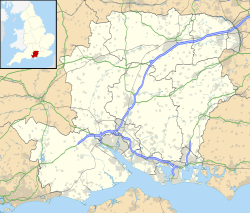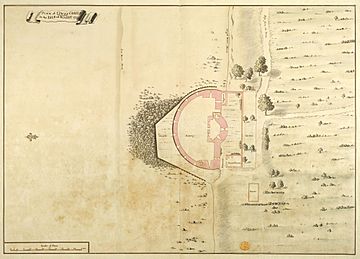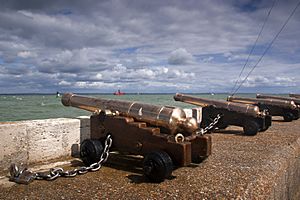Cowes Castle facts for kids
Quick facts for kids Cowes Castle |
|
|---|---|
| Isle of Wight, England | |
 |
|
| Coordinates | 50°45′59″N 1°18′04″W / 50.7665°N 1.3012°W |
| Type | Device Fort |
| Site information | |
| Owner | Royal Yacht Squadron |
| Open to the public |
No |
| Site history | |
| Built | 1539 |
| Events | English Civil War, Second World War |
|
Listed Building – Grade II
|
|
| Official name | West Cowes castle |
| Designated | 17 August 1951 |
| Reference no. | 1267310 |
Cowes Castle, also known as West Cowes Castle, is an old fort in Cowes on the Isle of Wight. King Henry VIII built it in 1539. Its main job was to protect England from possible attacks by France and the Holy Roman Empire.
The castle was built with a round bastion, side wings, and a keep. By 1547, it had 17 artillery guns. It stood at the entrance to the River Medina. This river was a very important place for ships to anchor.
Even after the threat of invasion passed, the fort stayed in use. It saw a little action in 1642 during the English Civil War. In 1854, the castle was no longer needed by the military. The Royal Yacht Squadron then leased and later bought it. They turned it into their clubhouse.
During the Second World War, Cowes Castle became a headquarters for the D-Day invasion forces. Today, it is still used by the Royal Yacht Squadron. It is a famous landmark during yacht races around the Isle of Wight.
Contents
History of Cowes Castle
Why Was Cowes Castle Built?
Cowes Castle was built because of big problems between England, France, and the Holy Roman Empire. This was in the last years of King Henry VIII's rule. Before this, local lords usually handled coastal defenses. The King didn't get involved much.
In 1533, Henry VIII broke away from the Pope. He wanted to end his marriage to Catherine of Aragon. Catherine was the aunt of Charles V, the Holy Roman Emperor. Charles V felt insulted by this.
In 1538, France and the Holy Roman Empire teamed up against Henry. The Pope even encouraged them to attack England. It looked like England was going to be invaded. So, in 1539, Henry ordered new forts to be built. These were called "device" forts. They were meant to defend England from invasion.
The Solent is a waterway that leads to the important ports of Southampton and Portsmouth. It was seen as an easy target for attack. So, two castles were built at the entrance to the River Medina. This river was the main harbor for the Isle of Wight. The castles were named after the area, "the Cowes."
The western fort, known as West Cowes Castle, was built in 1539. It had a D-shaped bastion at the front. Behind it was a round, two-story keep. There were also two low buildings on each side. All these parts held artillery guns. A ditch and a stone wall protected the land side. The castle was built using limestone ashlar stone. Some of this stone might have come from Beaulieu Abbey, which was torn down by Henry.
Towns grew up around both castles on the Medina. But the East Cowes Castle was soon left empty. It was eventually destroyed by the sea. That's why today, West Cowes Castle is usually just called Cowes Castle. In 1547, the fort had 17 iron and brass cannons. But nine of them didn't work. Still, it stayed a fort even after the invasion threat ended. It had a small group of soldiers, including a captain and gunners.
Cowes Castle Through the Centuries
Cowes Castle was used to house important visitors. It also served as a prison. The castle's captain also managed foreign ships arriving in the area. In 1642, the English Civil War began. This was a fight between King Charles I and Parliament. The castle was first held by the King's side.
On August 12, the castle's captain fired a gun at a nearby Parliament ship. A Scottish naval captain then captured the castle for Parliament. Parliament held the castle for the rest of the war.
During the time when England had no king, the castle was still a prison. In 1647, King Charles I couldn't stay there. The castle was full, so he stayed at a local alehouse instead. Sir William Davenant, a Royalist, was imprisoned at Cowes in 1650. He wrote a poem called Gondibert while he was there.
The sea caused problems for the castle's walls. In 1692, reports said the walls were cracked. They were at risk of falling down. In 1785, a historian noted the castle was "strongly fenced" to stop the sea.
In the 1700s, Cowes became a popular place for visitors. By the early 1800s, it was a well-known resort. Cowes Castle was partly rebuilt in 1716. This was to make the living areas better. The front of the keep was rebuilt with new windows. A new tower for a spiral staircase was added. New residential wings were also built. A garden was made over the old defenses.
In 1795, a writer said the castle's military use was "utterly useless." A guidebook in 1824 agreed. It called Cowes "useless as a place of defence." It even made fun of the guards on duty.
Lord Anglesey became the captain of Cowes Castle in 1826. This was more of an honorary title than a military job. He spent part of each year at the castle. He made many fancy improvements to the inside. Lord Anglesey was also a member of the Royal Yacht Squadron. This group started in 1815. They were based at the Gloster Hotel in Cowes.
Yachting became very popular in the area. The painter J. M. W. Turner drew yachts sailing near the castle in 1827. When Lord Anglesey died in 1854, the government closed the castle. They first leased it to Anglesey's son-in-law. Then, in 1855, they leased it to the Royal Yacht Squadron.
The Squadron hired Anthony Salvin, an architect. He was good at working with old buildings. He remodeled the castle between 1856 and 1858. He made the house bigger and changed its look. He built a new tower, platform, and a gatehouse. He also added a service wing, a ballroom, and more rooms for members. This cost about £6,000. Prince Albert and Edward, the Prince of Wales, visited the castle. It officially reopened in 1858. Some people didn't like the changes. One newspaper said it looked like a "discipline establishment."
Cowes became a major center for yachting. In 1877, a miniature frigate called the Royal Adelaide was destroyed. Its 21 brass cannons were given to the castle by the Prince of Wales.
Cowes Castle in Modern Times
The Royal Yacht Squadron bought Cowes Castle from the Crown in 1917. More work was done on the property in the 1920s. A ballroom from a nearby hotel was bought. It was used as an extra space for female members.
The Isle of Wight was important for the Allied invasion of France in the Second World War. By October 1942, the British Admiralty used the castle. It became the headquarters for a landing craft base. This base was known as HMS Vectis. The ships from this base were docked nearby. They took part in the D-Day landings. The castle was damaged during German bombing raids on the island.
After the war, architect A. G. Biggs made big additions to the castle. This was between 1962 and 1968. He changed the western part of the building. This provided more rooms for women. He used stone from the second East Cowes Castle. This was a large house that had been torn down the year before. A ready-made conservatory was added in 1988. A new pavilion, designed by Sir Thomas Croft, was added in 2000.
Archaeological excavations happened in the winter of 2010–11. They found the remains of the old castle wall and ditch. More than 400 items were found. They are now stored at the Isle of Wight County Museum. Cowes Castle is a famous landmark in yachting and powerboat events. It is especially important at the start and finish of local races. It is protected under UK law as a Grade II* Listed Building.
Images for kids
-
The castle by John Thomas Serres






